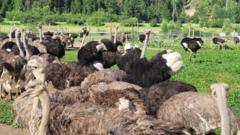Why Did Canada's Top Court Dismiss the Appeal to Stop the Ostrich Cull?

Published: 2025-11-06 17:00:18 | Category: world
The Supreme Court of Canada has declined to hear an appeal aimed at halting the culling of hundreds of ostriches at Universal Ostrich Farms in British Columbia, a situation sparked by an avian flu outbreak. This development significantly limits the legal recourse available to the farmers, who have been opposing the cull ordered by the Canadian Food Inspection Agency (CFIA) after two birds tested positive for the virus. The CFIA is now poised to proceed with the cull, leaving the farmers with a desperate plea for intervention.
Last updated: 29 October 2023 (BST)
What’s happening now
The refusal of the Supreme Court of Canada to hear the appeal has allowed the CFIA to legally proceed with the cull of hundreds of ostriches, a move that has garnered international attention and criticism. The CFIA stated it would be "moving forward" with the cull, although no specific timeline has been provided. The situation has prompted emotional responses from the farmers, who are seeking alternative measures to save their surviving birds, including potential appeals to the federal government for reconsideration.
Key takeaways
- The Supreme Court's decision paves the way for the culling of birds at Universal Ostrich Farms.
- The cull was ordered after two ostriches tested positive for avian flu.
- The farmers argue that the surviving birds could be used for scientific research.
- International figures, including US officials, have shown support for the farmers.
- Protests have been held at the farm in response to the cull order.
Timeline: how we got here
The legal battle surrounding Universal Ostrich Farms has unfolded over several months. Key dates include:
- September 2023: The CFIA took custody of the ostriches after the avian flu outbreak.
- Late 2022: The CFIA issued a cull order following positive tests for avian flu.
- October 2023: The Supreme Court of Canada refused to hear the farmers’ appeal, allowing the cull to proceed.
What’s new vs what’s known
New today/this week
The significant development this week is the Supreme Court's decision not to intervene in the culling order, effectively granting the CFIA the authority to move forward. This refusal has intensified the urgency for the farmers, who had hoped for legal recourse to stop the cull.
What was already established
Prior to the Supreme Court's decision, the CFIA had already mandated the cull due to concerns over avian flu and its potential risk to both wildlife and humans. The farmers have consistently disputed the necessity of the cull, arguing for the value of the surviving birds for research purposes.
Impact for the UK
Consumers and households
While the situation primarily concerns Canadian farmers, its implications may ripple through global avian farming practices. The culling of animals in response to disease outbreaks may influence UK farmers and consumers, particularly in discussions about animal welfare and food safety.
Businesses and jobs
The cull's impact on Universal Ostrich Farms may set a precedent affecting other agriculture businesses dealing with disease outbreaks. The loss of livestock can lead to financial strain, job losses, and disruption in supply chains.
Policy and regulation
This case could prompt discussions within UK regulatory bodies about how to handle similar avian flu outbreaks, balancing public health concerns with animal welfare considerations. The outcome of such discussions may shape future policies regarding animal culling and the use of animals in research.
Numbers that matter
- 69: The number of ostriches that died during the avian flu outbreak at Universal Ostrich Farms.
- 2: The number of birds that tested positive for avian flu, triggering the cull order.
- 60+: The approximate number of protesters who gathered at the farm following the Supreme Court's decision.
Definitions and jargon buster
- CFIA: Canadian Food Inspection Agency, responsible for safeguarding food, animal, and plant health in Canada.
- Avian flu: A viral infection that can infect birds and occasionally humans, posing health risks.
- Cull: The removal or killing of animals to control population or prevent disease spread.
How to think about the next steps
Near term (0–4 weeks)
In the immediate future, the focus will be on whether Universal Ostrich Farms will pursue alternative legal avenues or seek intervention from the federal government. The CFIA is likely to proceed with the cull, but public and political pressure may influence their timeline.
Medium term (1–6 months)
In the coming months, the effects of the cull on the farm's operations and local community will become clearer. This may also lead to broader discussions on animal welfare and public health, especially in relation to similar risks in the UK.
Signals to watch
- Updates from the CFIA regarding the timeline for the cull.
- Potential legal filings or appeals by the farmers.
- Public response and protests surrounding the issue.
Practical guidance
Do
- Stay informed about updates from the CFIA regarding the cull.
- Engage with local agricultural and animal welfare organisations for support.
- Advocate for clearer guidelines on animal culling in response to disease outbreaks.
Don’t
- Don’t overlook the implications of this case for animal welfare standards.
- Don’t dismiss the potential for public protest to influence policy changes.
- Don’t ignore the importance of scientific research in understanding animal diseases.
Checklist
- Review local regulations on animal health and welfare.
- Monitor social media campaigns supporting the farmers.
- Engage with community discussions about animal farming practices.
- Consider the broader implications for animal rights in agricultural policy.
Risks, caveats, and uncertainties
While the Supreme Court's decision is final, the situation remains fluid. The farmers may pursue other legal avenues, and public backlash could influence future decisions by the CFIA. Additionally, the ongoing discourse surrounding animal welfare and public health may evolve, reflecting changing societal values and legal standards.
Bottom line
The refusal of the Supreme Court of Canada to intervene in the ostrich cull has left farmers with limited options and raised significant ethical questions regarding animal welfare and public health. As the situation develops, the implications for Canadian agriculture and potential lessons for UK farming practices highlight the need for ongoing dialogue about animal rights and disease management.
FAQs
What is the reason for the cull of ostriches in Canada?
The cull was ordered by the Canadian Food Inspection Agency (CFIA) after two ostriches tested positive for avian flu, posing a risk to wildlife and human health.
Are there any alternatives to the cull being considered?
Farmers have suggested that the surviving ostriches could be used for scientific research, but the CFIA has rejected this proposal, asserting the need for culling.
What support have the farmers received?
The farmers have garnered support from various figures, including US officials and public personalities, advocating for the birds to be spared and studied instead of culled.



